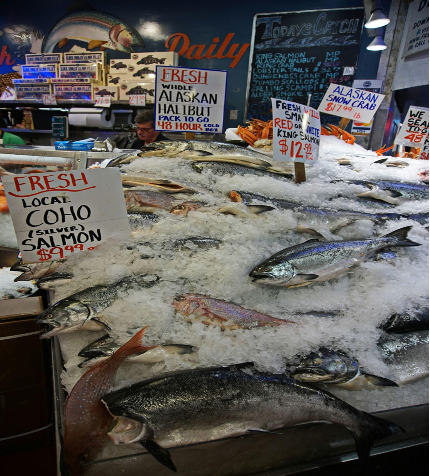By: Bianca Ortalano, Staff Writer

Photo courtesy of Unsplash.com
Do you know the difference between trout and salmon simply by looking at a filet? How about cod and tilapia? Many consumers are unaware that the fish they see on the menu or on a grocery store shelf is not the fish on the label. In 2013, the FDA performed a DNA test on seafood within the U.S. wholesale distribution chain.[1] In this study, the FDA tested samples from 14 states and found that fish species were correctly labeled only 85% of the time.[2] This study suggests that businesses that purchase seafood from wholesale markets may not even be aware that they are committing fish fraud and misleading their customers.
But first, what is fish fraud? The National Oceanic and Atmospheric Administration (NOAA) has identified three main types of fish fraud: seafood substitution, seafood short-weighting, and mislabeling.[3] Seafood substitution is where sellers will take advantage of the difficulty in recognizing the species of a fish once it has been skinned and fileted.[4]Sellers may substitute a fish species that is cheaper for one that is more expensive and hope that the buyer cannot tell the difference.[5] The FDA has recognized seven species of fish at the highest risk of substitution including cod, haddock, catfish, basa, swai, snapper, and grouper.[6] Even when the type of fish is correctly labeled, consumers can be misled by short-weighting. Processors may label the seafood product as heavier than it is due to certain techniques like using excess ice or additives.[7] Adding the weight of the additives and ice to the overall weight of the seafood will allow the processors to charge buyers more than what the seafood is worth.[8] Lastly, in addition to the mislabeling of the type of seafood, both the country of origin and whether the fish is farm-raised or wild-caught can be misrepresented as well.[9]From fraudulent trade documents to illegal transfers of the seafood, there are many ways for seafood to become mislabeled.[10]
Due to the prevalence of fish fraud, NOAA law enforcement has several procedures in place. Officials frequently board fishing vessels, inspect processing plants, patrol certain areas, and will investigate if there is any suspicion of fraudulent activity.[11] Furthermore, the FDA has produced naming guidelines that seafood producers must follow in order to truthfully represent their products. For example, the USDC will certify seafood products without a standard of identity, such as breaded fish sticks, that contain less than 50% fish flesh as long as there is a statement indicating the amount of fish flesh in the product.[12] This seafood naming guideline also indicates what market names are acceptable given a fish species’ common name. According to The Seafood List, which was most recently updated in January 2024, sellers may label Argentine Sea Bass (common name) as just Sea Bass (market name), or they can label a Black Bullhead (common name) as a Bullhead or Catfish (market name).[13]
In addition to these guidelines and law enforcement procedures, some seafood producers have begun tracking their products. GulfWild has created a live web interface that allows consumers to track their fish.[14] GulfWild’s “Transparensea” tags record the fish species, where and how it was caught, information about the fishing vessel and Captain, and more.[15] Another company, BlueTrace, created a tool that shellfish harvesters can use to log information.[16] These innovative tracking and logging systems allow consumers to strengthen their trust in the fishing industry by seeing the progression of their seafood.[17]
Consumers can further strengthen their trust in seafood products by using their own techniques when purchasing fish. First, asking questions about the fish can expose weak points. At grocery stores, asking the vendors at the seafood counter about the qualities of certain fish species and their origin allows them to show just how knowledgeable they are about their products. Asking questions about the seafood on the menu at restaurants can also provide insight into the fish. If vendors and restaurants are unable to answer basic questions, they may be unknowingly committing fish fraud against their customers. Secondly, a filet is much more indistinguishable compared to a whole fish. Buying a whole fish allows consumers to look for unique features of the species in order to confirm the type of fish they are buying. Furthermore, buying locally can help limit the various points that fish fraud can occur within the chain of seafood production. However, the reality is that fish fraud can occur at any level; from fishermen to wholesalers to grocery stores and restaurants. Take a closer look at the seafood you buy, ask questions, and if you suspect any fraudulent activity, you can call the NOAA enforcement hotline at (800) 853-1964.
[1] https://www.fda.gov/media/89937/download
[2] Id.
[3] https://www.fisheries.noaa.gov/national/sustainable-seafood/seafood-fraud
[4] Id.
[5] Id.
[6] https://www.fda.gov/media/89937/download
[7] https://www.fisheries.noaa.gov/national/sustainable-seafood/seafood-fraud
[8] Id.
[9] Id.
[10] Id.
[11] Id.
[12] https://media.fisheries.noaa.gov/dam-migration/part_5_grade_standards.pdf
[13]https://www.cfsanappsexternal.fda.gov/scripts/fdcc/index.cfm?set=SeafoodList&sort=ID_SciName&order=ASC&showAll=true&type=basic&search=
[14] https://www.gulfwild.com/Main/OurPromise
[15] https://www.gulfwild.com/Main/Programs/TransparenSea
[16] https://www.fisheries.noaa.gov/feature-story/bluetrace-wins-noaa-small-business-innovation-research-grant
[17] Id.